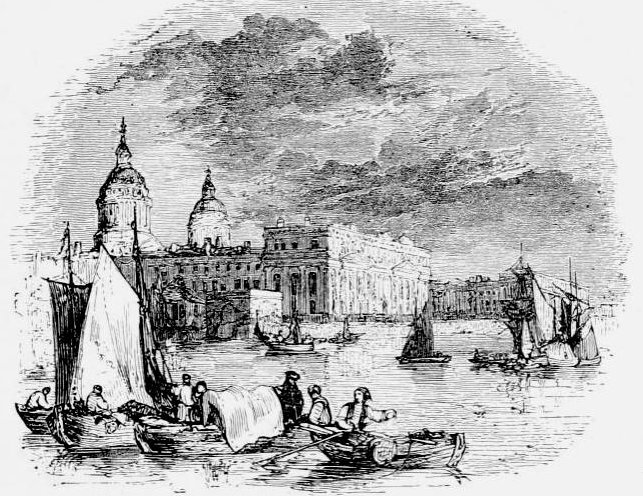
Greenwich Hospital. 1859. From The Book of the Thames from its Rise to its Fall, p. 474. Text and formatting by George P. Landow. [You may use this image without prior permission for any scholarly or educational purpose as long as you (1) credit the University of Pittsburgh and the Internet Archive and (2) link your document to this URL in a web document or cite the Victorian Web in a print one.]
Commentary by the Halls
We now arrive at Greenwich: that town has been famous since the days of the Saxons, who named it Grenewic, a name it has retained, with very slight alteration, to the present day. Its park is a favourite resort for Londoners; its hospital the pride of England.
We have been voyaging among the ships of all nations, with huge store-houses, quays, and wharves on either side; the river now, however, widens out, and begins to clear somewhat; the steam-boat has a freer pathway, and may proceed with less hazard of running down some barge or row-boat, of which there seems to the inexperienced eye a peril perpetual, all the way from the Tower, through "the Pool," and in the over-crowded highway that leads from London downwards. A sudden turn brings us within view of Greenwich. Those who approach the hospital by driving through any of the pleasant villages that divide it from London — nominally so, indeed, for the road is now a continuation of houses all the way — will see with exceeding delight the glory ot England, — the pride of every Englishman! Taken from any point of view it is "a palace" — beautiful in construction, graceful in all its proportions, as grand and imposing a structure as any nation of the modern world can show. But it is especially striking when seen as we voyage the Thames, either upwards or downwards; and dead must be the heart of him who does not share the sentiment — if he cannot repeat the lines — of the poet:-
Hail I noblest structure, imaged on the wave,
A nation's grateful tribute to the brave:
Hail: blest retreat from war and shipwreck, hail!
It is not because here many monarchs had their chosen seat, that as a "royal" palace it was famous for centuries — it is not even because it "gave Eliza birth" that we
Kneel and kiss the consecrated earth;"
but because here three thousand veterans repose after years of tempest and battle — maimed many of them, aged all of them; they have done their work; they have earned repose as the right of toil, and honour as the meed of victory.
The Old Palace at Greenwich, commenced by Duke Humphrey, commenced by the fourth Edward, added to by Henry VII., embellished by Henry VIII., by whom it was named Placentia, or "the Manor of Pleasaunce," and subsequently a favourite residence of Edward VI., Mary, Elizabeth, and the four kings of the Stuarts, and one of the dwellings of the Lord Protector — that is not the palace our brave seamen inhabit as their own "for ever." The present hospital stands partly on its site, and during the reign of William and Mary it was dedicated to its high and holy purpose — the good and merciful suggestion emanating from the queen. Although principally the work of the architect Wren, it was added to by successive sovereigns, and finally completed by George II. — large sums having been supplied for its "finishing" out of the forfeited estates of the Earl of Derwentwater (in 1715}, during the reign of George I. From these estates, the hospital still derives a revenue, augmented from other sources — a small tax upon all seamen, duties arising from certain lighthouses, market- rents in the town, and forfeited and unclaimed prize-money.
The "old sailors" have their library, their reading-room, their
picture-gallery (the famous Painted Hall, which contains a series of pictured
records of glorious sea-fights), their walks in piazzas, under shelter in
foul weather, and their park for promenade when the sun is shining;
their doctors, their nurses, their spiritual guides, and, above all, their
memories of the victories they have aided to win, and the knowledge
that duty and gratitude have provided for casing their ailments and
comforting their old age. [479-81]
![]()
Related Material
References
Hall, Samuel Carter, and A. M. Hall. The Book of the Thames from its Rise to its Fall. London: Arthur Hall, Virtue, and Cp., 1959. Internet Archive version of a copy in the William and Mary Darlington Memorial Libray, the University of Pittsburgh. Web. 10 March 2012.
Last modified 12 March 2012